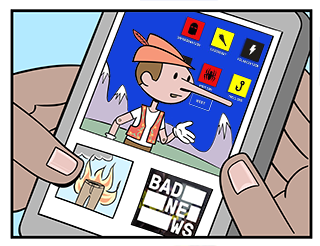Bad News!

Created as a partnership between the University of Cambridge and a Dutch media group called DROG, Bad News invites players to imagine themselves as purveyors of fake news. 1
In order to win the game, the player must abandon ethics altogether, building up followers while preserving some degree of credibility. If the player’s lies are too obvious, or if the player misreads the mood of the audience, they will lose the game.
Players can earn badges in six categories: impersonation (pretending to be someone credible), emotion (selecting images and content likely to provoke emotion), polarization (exploiting divisions between left and the right), conspiracy (developing ‘believable’ conspiracy theories), discrediting (attacking critics and undermining fact checkers), and trolling (using fake identities to steer online conversations).
Inspired by something known as “innoculation theory,” 2 the game’s creators share Propaganda Critic‘s belief that media literacy can function as a ‘vaccine’ against deception and propaganda. They point to a recent article in Scientific American which argues that training readers to be skeptical is the best strategy for combating fake news.3
The game’s objectives are elaborated in a short information sheet that educators might find helpful when using this tool in a classroom. The authors also include special instructions for educators and parents who might want to use the game with a small group of players.
“The game takes approximately 20 minutes to complete. It is suitable for use in class, for example during media literacy training. In our workshops we play the game first and then discuss the techniques that the students have acquired. We recommend dividing students up in pairs and having them play the game together while actively thinking about what they’re doing. In our experience, the game gives players decent (albeit somewhat limited) insight into the various tenets of disinformation and makes clear how easy it is to manipulate information.” 4
Bad News plays equally well on a cell phone and laptop. It is important to note that the game explores sensitive themes, and is not recommended for players under the age of 15. 5
References
1 According to their site, DROG is a “multidisciplinary team of academics, journalists and media experts” from all over Europe. See: DROG (2018) “About Bad News,” DROG: The Resistance to Disinformation.
2 In a recent interview with The Evening Standard, Dr. Sander van Linden, director of Cambridge’s Social Decision Making Laboratory explains that “A biological vaccine administers a small dose of the disease to build immunity. Similarly, inoculation theory suggests that exposure to a weak or demystified version of an argument makes it easier to refute when confronted with the more persuasive claims.” See: Amelia Heathman (2018, February 20) “If fake news is a disease, this Bad News game wants to be the vaccination,” Evening Standard. Link:
3 David Pogue (2017, February 1) “The ultimate cure for the fake news epidemic will be more skeptical readers,” Scientific American.
4 DROG (2018) “Bad news information sheet (PDF),” Bad News.
5 In an “Age Restrictions and Sensitivity Warning” appended to the end of the informational fact sheet, DROG notes that “The game contains some potentially emotionally charged content, such as information on a fictional plane crash, as well as existing conspiracy theories that might be considered jarring. The game does not employ violent imagery, swear words, or other offensive language. However, since players are prompted to take on the role of the ‘villain,’ they might experience some mild psychological discomfort about the decisions that the game pressures them into making. However, since the game takes place entirely in a virtual environment that does not affect the real online landscape, such discomfort should hopefully remain limited.”
